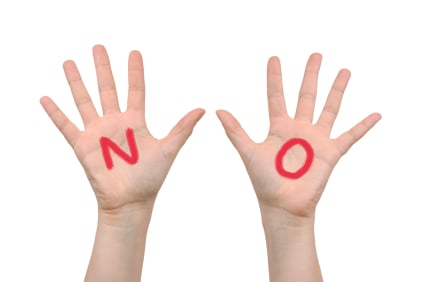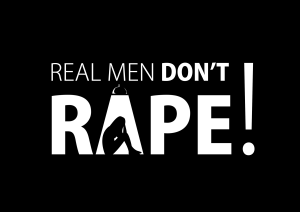
Credit: Pick The Brain
Just say “no.” That’s easy to say, more difficult to do. In real life, standing up for yourself is actually pretty hard.
Many of us insist that if we were intruded upon, we would set a firm limit. But when faced with a sticky situation, we often go quiet, get passive, or freeze.
Whether we’re facing a random person who stands too close on the subway, a pushy coworker, an intrusive relative, or a would-be rapist, many of us find it hard to assert our boundaries.
What Stands in the Way?
Socialization, mostly. Do any of these ring a bell?:
- “I don’t want to be rude.”
- “I don’t want to make a scene.”
- “What if I’m wrong?”
- “I want them to like me.”
- “I have to work with them.”
Listen to your internal voices and see where they’re shutting you down.
Women in particular have been socialized to value other people’s needs and feelings – often more than our own. So much so that many of us have a hard time knowing what we feel and what we want in any given situation.
If we can’t identify our feelings or needs, it’s impossible to put them out there.
And even when we know what they are, it can feel impossible to override the societal mandate to “be nice” so we can say our wants out loud.
You Deserve to Assert Your Boundaries and Be Respected
Regardless of what society has taught us, you completely and utterly deserve to have your boundaries be known and be respected by others.
And it’s critical you start believing that yourself, especially if you want others to as well. (To be clear, not communicating them doesn’t give anyone the right to violate your boundaries. People shouldn’t assume they know what’s okay and feel entitled do something without checking in with you. Seeing how people respond to your boundaries tells you if they’re intentionally violating them or if they didn’t mean to and want to respect them.)
If it’s still difficult to believe you deserve to have your “no” be respected, here are some challenging questions for you to consider:
- What’s the worst that could happen if you’re rude, if you hurt someone’s feelings, if you’re wrong?
- It’s okay to make a mistake, embarrass someone (maybe yourself), or even piss someone off. Do you believe that your safety – your physical, mental, emotional safety – is that important?
- Aren’t you worth it? If you’re going to speak up for yourself, you have to believe you’re worth standing up for.
You may think it’s not that big a deal that you loaned a friend your favorite earrings even though you didn’t really want to or agreed to e-mail the meeting notes although you felt you were carrying too much of the work.
But these interactions are the fabric of daily life, and they add up. As they do, they create how we relate to ourselves and how others relate to us.
And if you don’t practice using your “no” muscle in these lower threat situations, will you be prepared to say “no” when the stakes are higher? Hopefully you will, but why not practice it now?
The vast majority of attacks on women and girls are by people we know. Obviously in abusive relationships, it’s 100 percent people we know, but even in stalking and sexual assaults — despite what the movies would have us think — we’re not talking about “stranger danger.”
Most attacks start with words, and that’s one place we have a chance to interrupt them before they escalate. Even in situations where the attacker is a stranger, words often come before violence.
Okay, Now You’re Feeling More Ready to Assert Boundaries
So you’re feeling better about saying “no.” You’ve decided to speak up more.
How do you transform yourself into someone who can do that?
First and foremost, know what you want in that moment. As I said, this can be hard, so it’s good to practice by asking yourself often, “What do I want to happen here?”
That’s going to be your touchstone. Know what you want, and then tell the other person.
In a stressful situation, when you’re not sure what to say, ask yourself what you want and then tell them.
Simple examples include, “Please step back,” “Stop touching me,” “You need to leave now,” and “I want you to knock before you come in.”
Once you know what you want to say, here are a few tips on delivering that message:
- Use your voice, face, and body. All three channels of communication should be in synch to avoid mixed messages.
- Project confidence and calm. You can act serious and firm even when you’re panicked or furious.
- Repeat yourself. It may get them to do what you want. And if they don’t hear you, or respect your request, that gives you important information about them and their intentions.
- Stay on your own agenda. You don’t need to respond to diversions, threats, questions, blaming, guilt-tripping, and such. Just stick to your point. (See “Repeat yourself.”)
- Make no excuses. “No” is a complete sentence. Being polite is fine at first, but if they don’t respond, drop the niceties. You don’t need to explain yourself. You don’t need to apologize for how you feel or what you want. You also don’t have to wait for your “turn” in the conversation.
- Use statements, not questions. Say “Leave me alone,” not “Would you please leave me alone?”
- Tell them what they are doing that you don’t like. Say “You’re standing too close” rather than blaming them as a person with “You are such a jerk.” Avoid cursing, name-calling, put downs, and other things that could unnecessarily escalate the situation.
As with any new skill, you’ll be clumsy to start. That’s okay, and the more you do it, the easier it will get.
It’s worth it, because if you don’t have a heartfelt “no” in your life, all your yesses are compromised.
The beauty of having a firm “no” is that it allows you to say “yes” to the things you do want in your life.
And isn’t that the life you want to live?
Lauren R. Taylor is a Guest Writer for Everyday Feminism and teaches skills for stopping harassment, abuse, and assault with Defend Yourself. She started working to end gender-based violence in 1978 and somehow she’s still passionate and inspired. She loves her hometown of Washington, DC, and a vision of a better world.
Search our 3000+ articles!
Read our articles about:
Our online racial justice training
Used by hundreds of universities, non-profits, and businesses.
Click to learn more




















